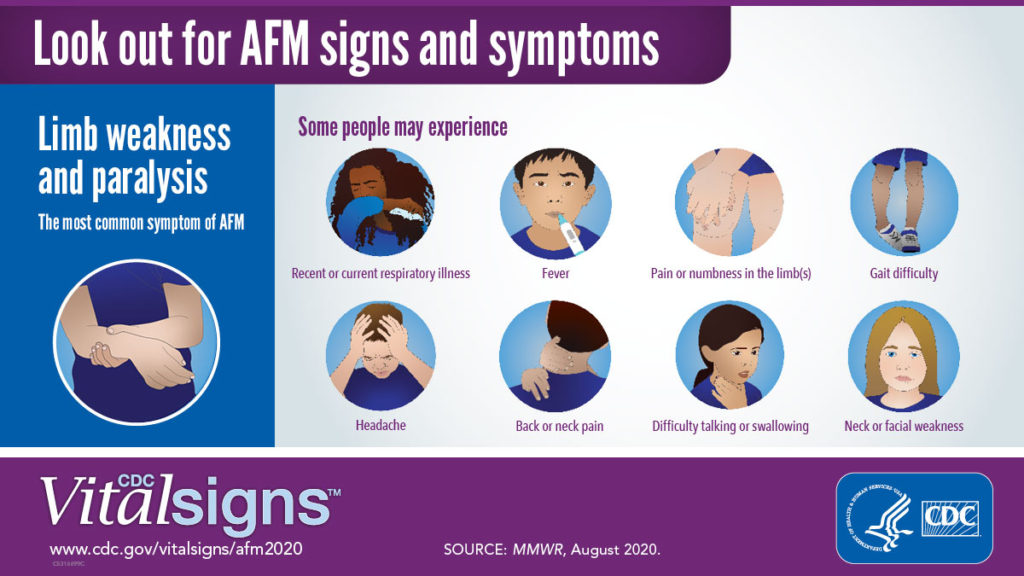By Staff Writer | August 4, 2020 | Spanish
The Centers for Disease Control and Prevention (CDC) anticipates that 2020 will be another peak year for cases of acute flaccid myelitis (AFM), an uncommon but serious neurologic condition that affects mostly children. The disease has peaked every two years between August and November in the United States since 2014. Enteroviruses, particularly enterovirus-D68 (EV-D68), are likely responsible for these peaks in cases.
CDC released a new CDC Vital Signs report to alert health care providers to a possible outbreak this year. This Vital Signs report reveals a delay in care for some patients in 2018: 35% of patients were not hospitalized until two or more days after limb weakness. AFM can progress rapidly over the course of hours or days, leading to permanent paralysis and/or the life-threatening complication of respiratory failure in previously healthy patients, so delays in care can be serious.
This Vital Signs report is intended to provide an anticipatory alert as we prepare for a possible outbreak this year.
Parents and doctors should suspect AFM in patients with sudden limb weakness, especially during August through November. Recent respiratory illness or fever and the presence of neck or back pain or any neurologic symptom should heighten their concern.
Pediatricians and frontline providers in emergency departments and urgent care centers should be prepared to quickly recognize symptoms of AFM and immediately hospitalize patients. Timing is critical at each step—prompt AFM recognition leads to optimal medical management and early specimen collection. When health care providers recognize symptoms as soon as possible, there is a better chance of detecting the cause of AFM, which might help predict the outcome. Other laboratory tests and an MRI of the brain and spinal cord can distinguish AFM from other conditions with limb weakness.
Robert Redfield, M.D., CDC Director
“As we head into these critical next months, CDC is taking necessary steps to help clinicians better recognize signs and symptoms of AFM in children,” said CDC Director Robert Redfield, M.D. “Recognition and early diagnosis are critical. CDC and public health partners have strengthened early disease detection systems, a vital step toward rapid treatment and rehabilitation for children with AFM.”
AFM is a medical emergency and patients should seek immediate medical care, even in areas with high COVID-19 activity. It is not known how the COVID-19 pandemic and the social distancing measures may affect the circulation of viruses that can cause AFM, or if COVID-19 will impact the health care system’s ability to promptly recognize and respond to AFM. If social distancing measures decrease circulation of enteroviruses this year, AFM cases may be fewer than expected or the outbreak may be delayed.
Thomas Clark, M.D., Deputy Director of CDC’s Division of Viral Diseases
“All clinicians should remain vigilant for AFM and promptly evaluate patients,” said Thomas Clark, M.D., deputy director of CDC’s Division of Viral Diseases. “During the COVID-19 pandemic, this may require adjusting practices to perform clinical evaluations of patients by phone or telemedicine. However, clinicians should not delay hospitalizing patients when they suspect AFM.”
Closer Review of AFM Peak in 2018
This Vital Signs report provides a more detailed view of clinical characteristics of AFM, which can help clinicians better recognize signs and symptoms, evaluate patients, and provide optimal medical management and rehabilitation.
The third and largest peak of AFM occurred in 2018, with 238 cases in 42 states. CDC reviewed the medical charts of AFM patients to collect more detailed information about their symptoms, exam, laboratory, and MRI findings, and where and when they sought medical care.
CDC’s review showed that in 2018:
• 76% sought medical care within one day, 64% presented to the emergency department
• 98% of patients with AFM were hospitalized
• 54% of patients were admitted to an intensive care unit; 1 in 4 hospitalized patients needed mechanical ventilation to help them breathe
Most cases were in children (94%) and most patients (86%) had AFM onset during August through November. Most patients had a fever and/or respiratory illness approximately six days before limb weakness onset. Other common early symptoms were difficulty walking, neck or back pain, fever, and limb pain.
While most patients were hospitalized within one day of limb weakness onset, 25% were not hospitalized until two to three days after, and 10% were not hospitalized until four or more days after their limb weakness began This could indicate delays in recognition and presents an opportunity for improvement.
CDC began surveillance for AFM in the United States in 2014, when the nation experienced the first peak of 120 cases, followed by peaks in 2016 (153 cases) and 2018 (238). Enteroviruses, particularly enterovirus-D68 (EV-D68), are likely responsible for these peaks in cases. EV-D68 is the most common virus identified among specimens collected from patients with AFM. However, other viruses can cause AFM and may also be contributing to the biennial peaks. Although AFM symptoms resemble those of polio, all specimens have tested negative for poliovirus. There is currently no specific test, proven treatment or prevention method for AFM.
For more information about AFM, visit: www.cdc.gov/acute-flaccid-myelitis/
To read more about the Nationwide Outbreak of Acute Flaccid Myelitis—United States, 2018 and the entire Vital Signs report, www.cdc.gov/vitalsigns.
About Vital Signs
Vital Signs is a report that appears as part of the CDC’s Morbidity and Mortality Weekly Report. Vital Signs provides the latest data and information on key health threats. Previous topics have included cancer, HIV/AIDS, prescription drug overdoses, antibiotic resistance, suicides, asthma, and global health.
Source: CDC


